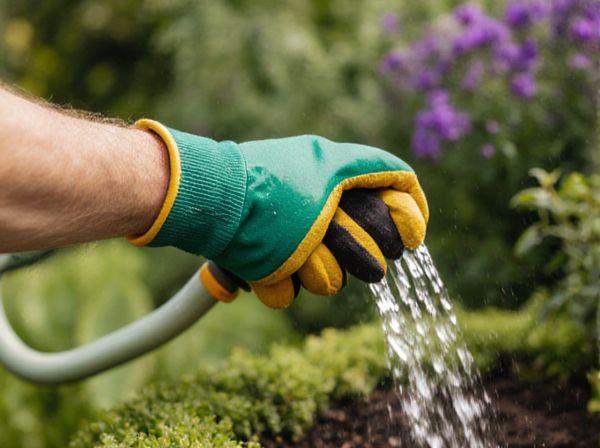
Foliar watering vs Soil watering Illustration
Foliar watering delivers moisture directly to plant leaves, enhancing nutrient absorption and promoting faster growth, especially during dry conditions. Soil watering targets the root zone, ensuring deep hydration and supporting overall plant stability and development. Balancing both methods can optimize plant health by addressing immediate leaf needs and sustaining long-term root moisture levels.
Table of Comparison
| Aspect | Foliar Watering | Soil Watering |
|---|---|---|
| Definition | Water applied directly to plant leaves | Water applied to the soil near plant roots |
| Absorption Rate | Fast through leaves | Slower via root uptake |
| Best For | Quick nutrient delivery and hydration | Deep root nourishment and water retention |
| Frequency | Often, in small doses | Less frequent, larger volumes |
| Ideal Conditions | Cool, early morning or late evening | Any time, avoids surface evaporation |
| Risks | Leaf burn if done in harsh sun | Overwatering risks root rot |
| Usage | Supplemental watering method | Primary watering method |
Understanding Foliar Watering: Definition and Basics
Foliar watering involves spraying water directly onto plant leaves, allowing nutrients and moisture to be absorbed through the stomata, enhancing nutrient uptake efficiency. This method contrasts with soil watering, where water is delivered to the root zone for absorption by roots. Understanding foliar watering is crucial for optimizing plant hydration, especially in dry or nutrient-deficient conditions, to promote healthier growth and faster recovery.
What Is Soil Watering? Key Principles Explained
Soil watering involves directly applying water to the root zone of plants, ensuring deep penetration and efficient nutrient absorption. Key principles include maintaining consistent moisture levels, avoiding waterlogging, and using appropriate watering intervals to support healthy root development. Proper soil watering enhances aeration and encourages robust plant growth by minimizing surface evaporation compared to foliar watering.
Advantages of Foliar Watering for Plant Health
Foliar watering allows plants to absorb nutrients and moisture directly through their leaves, promoting faster nutrient uptake and improved hydration. This method reduces soil-borne diseases by minimizing water contact with the soil surface, enhancing overall plant health. By targeting the foliage, foliar watering can effectively address micronutrient deficiencies and improve photosynthesis efficiency.
Benefits of Soil Watering in Garden Maintenance
Soil watering ensures deep root hydration, promoting stronger plant growth and enhancing nutrient absorption by delivering water directly to the root zone. This method reduces water evaporation and runoff compared to foliar watering, leading to more efficient water usage in garden maintenance. Consistent soil moisture also supports beneficial soil microorganisms, improving overall soil health and plant resilience.
Foliar vs. Soil Watering: Which Offers Better Nutrient Uptake?
Foliar watering allows plants to absorb nutrients directly through the leaves, resulting in faster and more efficient nutrient uptake compared to soil watering. Soil watering relies on root absorption, which can be slower due to factors like soil composition and microbial activity affecting nutrient availability. Studies indicate that combining foliar and soil watering maximizes nutrient absorption, improving overall plant health and growth.
Choosing the Right Method: Plant Types and Growth Stages
Foliar watering is ideal for young seedlings and plants with delicate leaves, delivering nutrients directly to the foliage for faster absorption and growth stimulation. Soil watering suits mature plants and those with deep root systems, ensuring thorough hydration and nutrient uptake at the root level for sustained development. Selecting the right method depends on plant species, leaf sensitivity, and specific growth stages to maximize water efficiency and promote healthy growth.
Potential Risks: Common Problems of Foliar and Soil Watering
Foliar watering can lead to fungal diseases like powdery mildew and leaf spot due to moisture lingering on leaves, especially in humid environments. Soil watering risks include root rot and nutrient leaching when over-applied or poorly drained, compromising plant health. Both methods require careful timing and technique to minimize potential problems and ensure effective hydration.
Best Practices for Foliar Watering in the Garden
Foliar watering involves spraying water directly onto the leaves, enhancing nutrient absorption and promoting faster growth compared to soil watering. Best practices for foliar watering include spraying early in the morning or late in the evening to minimize evaporation and avoid leaf burn, using clean, room-temperature water, and applying a fine mist evenly across the plant surfaces. Avoid over-wetting to prevent fungal diseases, and target the undersides of leaves where stomata are more abundant for optimal water uptake.
Soil Watering Techniques for Improved Root Development
Deep soil watering techniques enhance root development by encouraging roots to grow downward in search of moisture, resulting in stronger and more resilient plants. Methods such as drip irrigation, soaker hoses, and slow-release watering systems ensure consistent moisture delivery directly to the root zone, minimizing evaporation and surface runoff. Maintaining optimal soil moisture through proper soil watering improves nutrient uptake and promotes healthy microbial activity essential for robust root growth.
How to Combine Foliar and Soil Watering for Optimal Results
Combining foliar and soil watering enhances plant hydration by addressing both immediate leaf moisture and deep root nourishment, promoting faster nutrient absorption and stronger growth. Foliar watering should be applied during cooler parts of the day to prevent leaf burn, while soil watering ensures consistent moisture levels in the root zone. Optimal results are achieved by alternating foliar sprays with thorough soil irrigation, tailored to the specific plant species and environmental conditions.
Foliar watering vs Soil watering Infographic

 gardendif.com
gardendif.com